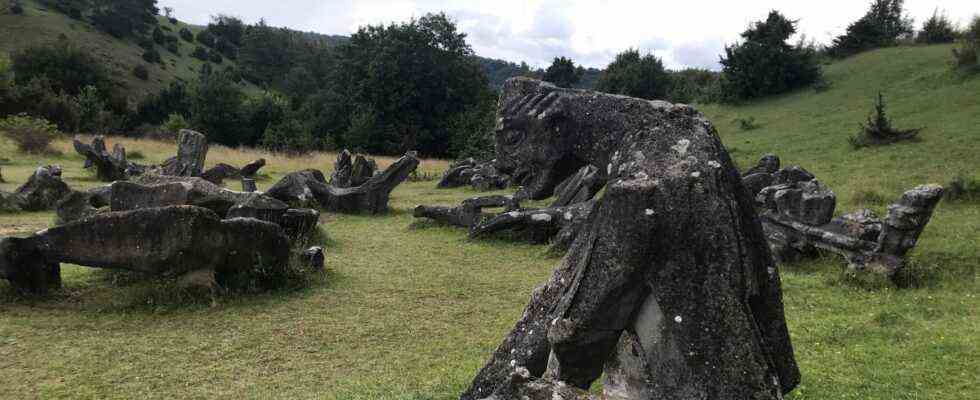As Hans Bittl is about to explain the figure field, two young men approach. They want to know what the significance of the stone formations is. Bittl already starts. One of the men holds onto it with the camera, the spontaneous tour is recorded for the followers on the net.
Bittl is the chairman of the board of trustees for the memorial against war in Eichstätt. The curious visitors have found exactly the right person for their spontaneous interview. Bittl has roamed the figure field countless times, he knows each of the 81 figures from all perspectives. The memorial is not overcrowded on this cloudy August day, only a few hikers stroll through the field of figures. Even when the weather is good, there is seldom much going on here: the memorial is little known across the region and beyond artistic circles.
The sculptures, which together weigh around 800 tons, form a battlefield with which the Eichstatt artist and sculptor Alois Wünsche-Mitterecker wanted to illustrate the senselessness of war. In view of the numerous theaters of war around the world, his work of art has a shamefully current character. The stone figures represent dying, dead, fighting and survivors. Wounded horses and parts of war machinery are also recognizable.
The artist, who died in 1975, chose a dreamy place to portray the horror. Sounds macabre, but it was exactly what I wanted. The figure field is embedded in nature in the Hessental east of Eichstätt, framed by hedges and juniper bushes on poor grass. Sometimes a shepherd grazes his sheep on the slope opposite. With its picturesque hills and hollows, the Hessental could serve as a backdrop for the Shire in Lord of the Rings.
The twelve-kilometer tour starts and ends at the hiking car park in the Hessental. Follow the signs for loop path 14. The figure field is a few minutes’ walk away. We continue north to a chapel near the Häringhof. Continue past here in the direction of the Ziegelhof. There right towards the forest and a good bit through it. At the Sacred Heart Grotto, turn right again south into the forest. At the bottom of the wooden bridge, turn right towards Landershofen and the parking lot. If you want, you can make a detour to the historic Altmühlbrücke.
The memorial was opened in 1979, and the artist planned and built it for more than twenty years. It can be reached from two parking spaces. Either from the hiking car park in the Hessental on Pfünzerstraße, from where you can reach the figure field via a field path or a little further to the left over the hills in a few minutes’ walk. Or you can get to the Jura High Street above the figure field, where the parking lot is signposted and is closer to the figure field. It can be accessed free of charge at any time of the year.
Wish Mitterecker knew “that the war has no victors or vanquished, but only chaos, death and destruction”
Visitors to the figure field look in vain for detailed information boards or even explanations for individual figures. But the memorial also works without big words. The larger-than-life figures are sometimes easily recognizable as humans, animals or machines, sometimes they are completely abstract. There is no center of battle. Rather, step by step, new perspectives and thus new relationships between the characters emerge. Sometimes they correspond with each other, sometimes they stand completely on their own. Some crawl away, just away from the slaughter, some are in the middle of a battle. Just as it might look on a “real” battlefield.
Wish-Mitterecker has seen such war scenes himself enough: During the Second World War he was employed as a war draftsman at the front. What he had to record there down to the smallest detail, he could not let go. The memorial, which is now a listed building, is his life’s work. His therapy. “He knew that the war had no winners or vanquished, but only chaos, death and destruction,” explains tour guide Hedwig Kölle, who regularly offers tours through the field of figures.
In the footsteps of robbers and generals: For a few weeks now, the SZ-Bayern editorial team has been exploring unknown routes throughout the Free State in order to present new destinations for a holiday at home. The previous episodes of the series have now appeared bundled in digital form. You can now find the dossier in the digital kiosk of Süddeutsche Zeitung and on the Internet at www.sz.de/ausflug2.
She can remember one group particularly well. “They were old men, some of whom were at war themselves,” she says. “Then a man’s daughter called me and said that some of the men cried unrestrainedly on the bus on the way home.” The figure field brought back terrible memories. The figure field also causes anxiety among visitors who never had to experience the war themselves.
Every now and then families with children roam the field. Signs on the edge of the figure field state that climbing the figures is prohibited. But because children are children, they climb onto the figures. You have no idea what the stone blocks represent. Some parents chase their protégés back down immediately, some let them go. “Climbing is disrespectful,” says Bittl. “It also damages the figures. And the weather does the rest,” he adds, pointing to a figure from which parts of the cement mixture are crumbling.
Together with the Bavarian State Office for Monument Preservation, the Board of Trustees is currently planning the renovation. The two information boards at the parking lots are also to be revised. But many lines should not be added. The visitors should continue to form their own picture of the war memorial.

